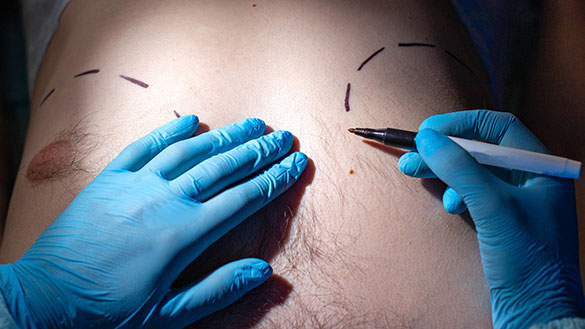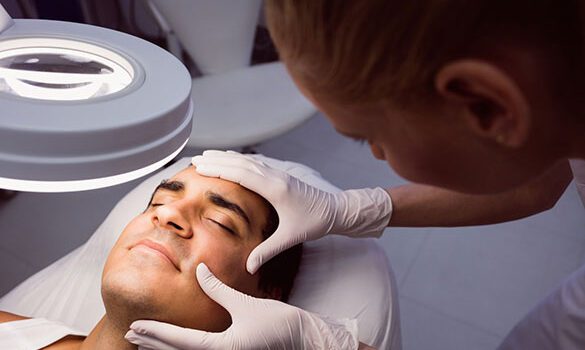Gynecomastia, more commonly known as overdeveloped or enlarged breasts in men, can cause emotional discomfort and have a negative impact on men’s self-esteem and self-confidence. This may lead some men to avoid certain physical activities or intimacy to conceal their condition.
The good news is, there are gynecomastia treatment options to help men reduce the appearance of their breast tissue. At GraceMed, we specialize in Gynecomastia surgery, also known as mammoplasty or male breast reduction, in Toronto and across the GTA.
Learn more about gynecomastia, it’s causes, and your treatment options. If you are a good candidate for gynecomastia surgery, get in touch to learn more about your options and what a GraceMed surgeon can do for you.
What is gynecomastia?
Gynecomastia is a condition of overdeveloped or enlarged breasts in men that can occur at any age. Gynecomastia can result from hormonal changes, heredity, obesity, weight loss, or the use of certain drugs.
Gynecomastia is typically characterized by excess localized fat, excess glandular tissue development, excess breast skin, and may be present unilaterally (one breast) or bilaterally (both breasts).
How is Gynecomastia diagnosed?
Your healthcare provider will perform a physical exam and take a complete medical history from you. To rule out other diseases or conditions, your healthcare provider may also advise tests including blood tests (including liver function and hormone studies), urine tests, x-ray of your breast(s),. In some cases, a small breast tissue sample, also known as a biopsy, may be removed to check for cancer cells.
In most cases, these tests are not required to diagnose gynecomastia. However, your healthcare provider will make the appropriate recommendation depending on your individual medical history and physical condition.
How is Gynecomastia treated?
After the cause of your gynecomastia is accessed, your healthcare provider will be able to provide you with treatment options.
For men who developed gynecomastia because of taking a prescribed medication, your healthcare provider may recommend switching medications. For some, gynecomastia is a result of hormone imbalance, in which case hormone therapy may be recommended as a treatment.
For many men, their gynecomastia may not be the result of prescription medication or hormone imbalances, in which case surgery may be a treatment recommendation.

What is a gynecomastia surgery?
Gynecomastia surgery is performed by a plastic surgeon and is a procedure that removes excess fat and tissue from the male breast(s), which helps flatten and enhance the male chest contours. In most cases of gynecomastia, liposuction in used to remove the excess fatty tissue of the breast(s).
The procedure of treating gynecomastia with liposuction is performed using either local or general anesthesia and involves a small incision on each side of the chest. However, depending on your aesthetic goals and your plastic surgeon’s technique, you may also have incisions located along the edge of the areola and within the armpit.
Your plastic surgeon will remove the excess fat and/or tissue while simultaneously sculpting a new chest contour that looks natural to your body.
In severe cases of gynecomastia, you may require more extensive surgical tissue excision to achieve optimal results.
Additionally, the weight of the excess breast tissue may cause the breast(s) to sag and stretch the areola (dark skin around the nipple). In which case, the position and size of the areola can be surgically improved, and the excess skin may be reduced.
The location and length of the incisions depend on the extent of the surgery needed but are typically located around the areola or within the natural crease of the chest.
Your healthcare provider may be able to refer you to a plastic surgeon to discuss your individual case and to see if you’re a candidate for gynecomastia surgery. GraceMed is a premium plastic surgery clinic that offer gynecomastia surgery, with locations in both Toronto and the GTA.
Are there other procedures I should consider in addition to a gynecomastia surgery?
Men who undergo a gynecomastia procedure may also decide to pursue additional plastic surgery procedures that complement their gynecomastia procedure. Commonly men will also have abdominal liposuction and/or a tummy tuck to address excess skin and fat on their abdomen.
Adding abdominal plastic surgery may enhance your gynecomastia result as you would be addressing the full front of your torso. By combining gynecomastia with abdominal liposuction or tummy tuck, you may further tighten and contour the entire chest and abdomen. You should consult with your plastic surgeon to determine if you are a candidate for combining both a gynecomastia and abdominal surgical procedure.

Who is a good candidate for gynecomastia surgery?
After meeting with your healthcare professional to discuss your gynecomastia, you may want to explore your surgical treatment options. If you are interested in learning more about surgery for gynecomastia, your healthcare provider will recommend you meet with a plastic surgeon.
The plastic surgeon will re-examine your gynecomastia concerns and decide if you’re an appropriate candidate for gynecomastia surgery.
Good candidates for gynecomastia surgery include:
- Men whose condition cannot be corrected through alternative medical treatments.
- Healthy individuals who do not have a life-threatening illness of medical conditions that can impair healing.
- Non-smokers, and non-drug users.
- Men who are physically healthy and of a relatively normal weight.
- Men whose breast development has stabilized.
- Men who are bothered by the feeling that their breasts are too large.
Is there anyone who shouldn’t have gynecomastia surgery?
During a consultation with a plastic surgeon, they will review your current physical condition and entire medical history to decide if you are an appropriate candidate for surgery. There are a few contributing factors to men who may not be advised to have a gynecomastia surgery such as:
Weight
Men who are overweight or obese may be advised to lose weight prior to undergoing surgery. Weight loss is often recommended to have a safer surgery and to achieve a better surgical result.
Your plastic surgeon will take your current weight at your consultation appointment to establish your Body Mass Index (BMI) which helps determine if you are a safe candidate for surgery. Your surgeon will be able to provide you with a goal weight for your surgery to help you set a realistic goal for weight loss.
Smoking
Men who smoke are advised to quit at least two months prior to having gynecomastia surgery to ensure a safer surgical procedure and recovery. Quitting smoking is required as smoking reduces your blood flow, therefore your surgical incisions are more likely to become infected since reduced blood flow slows down healing.
Smoking also compromises your heart function, which puts patients who smoke at a greater risk of problems during and after surgery. Furthermore, anesthesiologists work harder to keep smokers breathing while under anesthesia as they are fighting against lungs that are compromised by cigarette smoke.
The anesthesiologist may recommend the use of a bronchodilator medications that assist with opening the lungs while under general sedation.
Age
Your plastic surgeon may also consider your age when determining your candidacy for gynecomastia surgery. Gynecomastia can affect men of all ages, men who are in their late teens and early twenties may still be developing physically.
There is no specific age one can have gynecomastia surgery and adolescents may benefit from gynecomastia surgery. A secondary procedure may be required in the future should the breast development continue.

What should you do to prepare for a gynecomastia surgery?
Once you confirm with your plastic surgeon that you’re a good candidate for a gynecomastia surgery, you can schedule a date for your surgical procedure. To prepare for your surgery, you should discuss with your surgeon how much time off work you may require for recovery.
Review with your surgeon what pain medication you may be prescribed so that you can fill the prescription prior to your surgery and have it ready for your recovery process. You will also want to make sure you have the recommended compression garments ready to wear home from the surgery if advised.
You may also want to review with your plastic surgeon if you will have drains after your surgery. Drains collect fluid externally, to help reduce the chance of fluid collecting internally which may cause complications. Therefore, you may want to review with your surgeon how to monitor your drains if you require them.
What are the risks of gynecomastia surgery?
The decision to have plastic surgery is very personal, and you will have to decide if the benefits will achieve your goals and if the risks and potential complications of gynecomastia surgery are acceptable for you.
Your plastic surgeon will review with you the potential risks and complications associated with gynecomastia surgery and will have you sign consent forms to ensure you fully understand.
Gynecomastia surgery risks include:
- Anesthesia risks
- Bleeding (hematoma)
- Blood clots
- Breast asymmetry
- Changes in nipple or breast sensation may be temporary or permanent
- Damage to deeper structures – such as nerves, blood vessels, muscles and lungs
- Deep vein thrombosis, cardiac and pulmonary complications
- Fatty tissue found in the breast might die (fat necrosis)
- Infection
- Possibility of revision surgery
If you have any questions regarding associated with undergoing surgery, it’s important that you ask your plastic surgeon so that they can address them with you directly.
What is the recovery like after a gynecomastia surgery?
For patients who only require liposuction to correct their gynecomastia, the recovery process is approximately 1 to 2 weeks before returning to most physical activities.
For patients who require incisions and more extensive methods to remove excess breast tissue, it can up to 4 weeks to heal enough to tolerate more physical activities.
Most patients are able to return to work after 1 week but are not able to lift or perform strenuous physical labour. Therefore, patients who work in physically demanding jobs may be required to recover longer prior to returning to work in comparison to patients with less physically demanding jobs.
Patients are prescribed pain medications to help handle any discomfort associated with recovering from the gynecomastia procedure. However, most patients find the pain is tolerable with over-the-counter pain medications such as ibuprofen products. Overall, most patients experience minimal discomfort or pain following their gynecomastia procedure.
How do I maintain my gynecomastia surgery results?
The results from a gynecomastia procedure are meant to be permanent as the excess fat, breast tissue and skin have been surgically removed. However, it is important to maintain a healthy lifestyle to ensure your surgical results stay intact.
Significant weight gain, steroid use, or certain medical conditions could result in a recurrence of gynecomastia. Drugs that influence testosterone levels could also affect your surgical results. You should review your medications in detail with your plastic surgeon prior to undergoing a gynecomastia procedure to have a realistic idea about what results you could achieve.

How do I select which surgeon to go to for a gynecomastia surgery?
Research
You can research plastic surgeons in your area to see if any of them offer and specialize in gynecomastia procedures. Your family physician may also be able to make a referral for you to meet with a plastic surgeon, however a referral is not required to meet with a plastic surgeon regarding gynecomastia as the procedure is typically not covered by health insurance.
Credentials
Once you’ve started researching plastic surgeons in your area, you should look at the surgeon’s credentials to ensure that they are a board-certified plastic surgeon.
Results
You may also want to review before and after photo gallery of patients who have already undergone a gynecomastia surgery.
Reviewing the before and after images will be helpful in deciding which surgeon to go to, as you can examine the surgeon’s work and technique. You may also want to examine the plastic surgeon’s patient testimonials that share how previous patients found their overall experience to be with that plastic surgeon.
Consultation
Once you’ve researched plastic surgeons in your area, it’s a good idea to schedule a consultation to meet with the surgeon in person to discuss your surgical goals. During the consultation, your plastic surgeon will be able to determine if you’re an appropriate surgical candidate and explain which method of surgery they would recommend addressing your gynecomastia concerns.
If you have any questions, you should ask the surgeon to ensure you have all your questions answered so that you are best able to make a decision about having the surgery. You may wish to have consultations with a few plastic surgeons to determine which surgeon you felt the most comfortable with.
GraceMed offers consultations with plastic surgeons in Toronto and the surrounding GTA and have surgeons who are experts in gynecomastia procedures.
Aftercare
Something else you may consider when selecting a plastic surgeon is the aftercare they are able to provide. Some clinics offer scar management therapy which include laser treatments for surgical patients once their scars have completely healed. Laser treatments for scarring can help the pigment of the scar, some clinics include laser therapy for scarring in the cost of the surgery.
Ultimately, you should pick a plastic surgeon that you feel you’re most comfortable with and agree upon a surgical plan with. You should never feel pressured into making a big decision like having surgery, be sure to review your options and make the decision that is right for you.
















